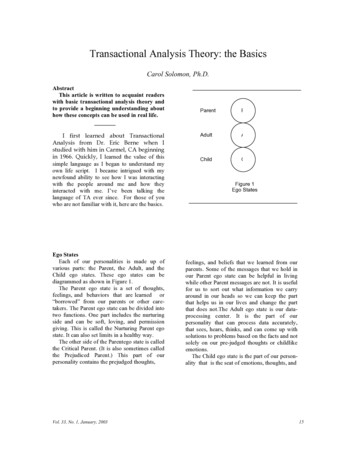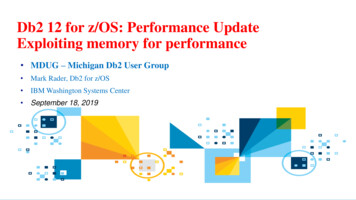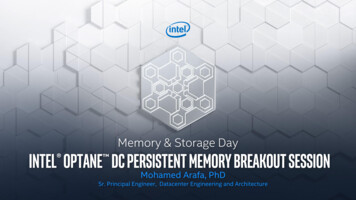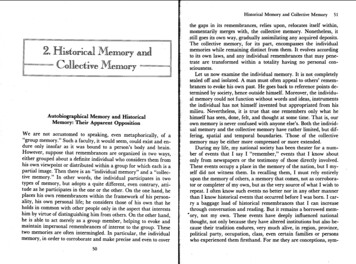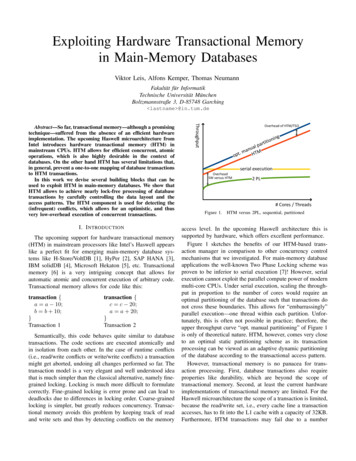
Transcription
Exploiting Hardware Transactional Memoryin Main-Memory DatabasesViktor Leis, Alfons Kemper, Thomas NeumannFakultät für InformatikTechnische Universität MünchenBoltzmannstraße 3, D-85748 Garching lastname @in.tum.deI. I NTRODUCTIONThe upcoming support for hardware transactional memory(HTM) in mainstream processors like Intel’s Haswell appearslike a perfect fit for emerging main-memory database systems like H-Store/VoltDB [1], HyPer [2], SAP HANA [3],IBM solidDB [4], Microsoft Hekaton [5], etc. Transactionalmemory [6] is a very intriguing concept that allows forautomatic atomic and concurrent execution of arbitrary code.Transactional memory allows for code like this:transaction {a a 10;b b 10;}Transaction 1transaction {c c 20;a a 20;}Transaction 2Semantically, this code behaves quite similar to databasetransactions. The code sections are executed atomically andin isolation from each other. In the case of runtime conflicts(i.e., read/write conflicts or write/write conflicts) a transactionmight get aborted, undoing all changes performed so far. Thetransaction model is a very elegant and well understood ideathat is much simpler than the classical alternative, namely finegrained locking. Locking is much more difficult to formulatecorrectly. Fine-grained locking is error prone and can lead todeadlocks due to differences in locking order. Coarse-grainedlocking is simpler, but greatly reduces concurrency. Transactional memory avoids this problem by keeping track of readand write sets and thus by detecting conflicts on the memoryThroughputAbstract—So far, transactional memory—although a promisingtechnique—suffered from the absence of an efficient hardwareimplementation. The upcoming Haswell microarchitecture fromIntel introduces hardware transactional memory (HTM) inmainstream CPUs. HTM allows for efficient concurrent, atomicoperations, which is also highly desirable in the context ofdatabases. On the other hand HTM has several limitations that,in general, prevent a one-to-one mapping of database transactionsto HTM transactions.In this work we devise several building blocks that can beused to exploit HTM in main-memory databases. We show thatHTM allows to achieve nearly lock-free processing of databasetransactions by carefully controlling the data layout and theaccess patterns. The HTM component is used for detecting the(infrequent) conflicts, which allows for an optimistic, and thusvery low-overhead execution of concurrent transactions.Overhead of HTM/TSOingtionrtil pa.moptaanu MHTserial executionOverheadSW versus HTM2 PL# Cores / ThreadsFigure 1.HTM versus 2PL, sequential, partitionedaccess level. In the upcoming Haswell architecture this issupported by hardware, which offers excellent performance.Figure 1 sketches the benefits of our HTM-based transaction manager in comparison to other concurrency controlmechanisms that we investigated. For main-memory databaseapplications the well-known Two Phase Locking scheme wasproven to be inferior to serial execution [7]! However, serialexecution cannot exploit the parallel compute power of modernmulti-core CPUs. Under serial execution, scaling the throughput in proportion to the number of cores would require anoptimal partitioning of the database such that transactions donot cross these boundaries. This allows for “embarrassingly”parallel execution—one thread within each partition. Unfortunately, this is often not possible in practice; therefore, theupper throughput curve “opt. manual partitioning” of Figure 1is only of theoretical nature. HTM, however, comes very closeto an optimal static partitioning scheme as its transactionprocessing can be viewed as an adaptive dynamic partitioningof the database according to the transactional access pattern.However, transactional memory is no panacea for transaction processing. First, database transactions also requireproperties like durability, which are beyond the scope oftransactional memory. Second, at least the current hardwareimplementations of transactional memory are limited. For theHaswell microarchitecture the scope of a transaction is limited,because the read/write set, i.e., every cache line a transactionaccesses, has to fit into the L1 cache with a capacity of 32KB.Furthermore, HTM transactions may fail due to a number
T1T2T2T3Table IT RANSACTION RATES FOR VARIOUS SYNCHRONIZATION METHODST1T3Figure 2. Static partitioning (left), Optimistic concurrency control via HTMresulting in dynamic partitioning (right)of unexpected circumstances like collisions caused by cacheassociativity, hardware interrupts, etc. Therefore, it does notseem to be viable to map an entire database transaction to asingle monolithic HTM transaction. In addition, one alwaysneeds a “slow path” to handle the pathological cases (e.g.,associativity collisions).We therefore propose an architecture where transactionalmemory is used as a building block for assembling complexdatabase transactions. Along the lines of the general philosophy of transactional memory we start executing transactionsoptimistically, using (nearly) no synchronization and thusrunning at full clock speed. By exploiting HTM we get manyof the required checks for free, without complicating thedatabase code, and can thus reach a much higher degree ofparallelism than with classical locking or latching. In order tominimize the number of conflicts in the transactional memorycomponent, we carefully control the data layout and the accesspatterns of the involved operations, which allows us to avoidexplicit synchronization most of the time.Note that we explicitly do not assume that the database ispartitioned in any way. In some cases, and in particular for thewell-known TPC-C benchmark, the degree of parallelism canbe improved greatly by partitioning the database at the schemalevel (using the warehouse attribute in the case of TPC-C).Such a static partitioning scheme is exemplified on the lefthand side of Figure 2. VoltDB for example makes use of staticpartitioning for parallelism [1]. But such a partitioning is hardto find in general, and users usually cannot be trusted to findperfect partitioning schemes [8]. In addition, there can alwaysbe transactions that cross partition boundaries, as shown bythe partition boundary overlapping transactions T1, T2, andT3 in Figure 2 (left-hand side). These transactions have tobe isolated with a serial (or locking-based) approach as thestatic partitioning scheme cannot guarantee their isolation. Ifavailable, we could still exploit partitioning information in ourHTM approach, of course, as then conflicts would be evenmore unlikely. But we explicitly do not assume the presenceof such a static partitioning scheme and rely on the implicitadaptive partitioning of the transactions as sketched on theright-hand side of Figure 2.II. BACKGROUND AND M OTIVATIONAs databases are expected to offer ACID transactions, theyhave to implement a mechanism to synchronize concurrenttransactions. The traditional concurrency control method usedsynchronization method1 thread4 threads2PLserial execution50,541129,937108,756(129,937)manually partitioned, serial119,232369,549in most database systems is some variant of two-phase locking(2PL) [9]. Before accessing a database item (tuple, page,etc.), the transaction acquires a lock in the appropriate lockmode (shared, exclusive, etc.). Conflicting operations, i.e.,conflicting lock requests, implicitly order transactions relativeto each other and thus ensure serializability.In the past this model worked very well. Concurrent transaction execution was necessary to hide I/O latency, and the costsfor checking locks was negligible compared to the processingcosts in disk-based systems. However, this has changed inmodern systems, where large parts of the data are kept inmain memory, and where query processing is increasinglyCPU bound. In such a setup, lock-based synchronization constitutes a significant fraction of the total execution time, insome cases even dominates the processing [7], [10].This observation has motivated some main-memory basedsystems to adopt a serial execution model [7]: Instead of expensive synchronization, all transactions are executed serially,eliminating any need for synchronization. And as a mainmemory based system does not have to hide I/O latency, sucha model works very well for short, OLTP-style transactions.Table I shows TPC-C transaction rates under these twomodels. We used our HyPer system [2] as the basis for theexperiments. Clearly, the serial execution mode outperforms2PL. Due to the inherent overhead of maintaining a synchronized lock manager in 2PL, serial execution achieves 2.6 timesthe transaction rate of 2PL. This is a strong argument in favorof the serial execution mode proposed by [7]. On the otherhand, the figure also shows the weakness of serial execution:Increasing the degree of parallelism in 2PL increases thetransaction rate. Admittedly the effect is relatively minor inthe TPC-C setting, using 4 threads results in a speedup of only2, but there still is an effect. Serial execution cannot make useof additional threads, and thus the transaction rate remainsconstant. As the number of cores in modern systems growswhile single-threaded performance stagnates, this becomesmore and more of a problem.Systems like H-Store/VoltDB [1] or HyPer [2] tried tosolve this problem by partitioning the data. Both systemswould partition the TPC-C workload along the warehouseattribute, and would then execute all transactions concurrentlythat operate on separate warehouses. If transactions accessmore than one warehouse, the system falls back to the serialexecution model. In the TPC-C benchmark this occurs forca. 11% of the transactions. Nevertheless, this model worksrelatively well for TPC-C, as shown in Figure I, where it isabout 3 times faster than serial execution for 4 threads. But it
is not very satisfying to depend on static partitioning.First of all, it needs human intervention. The database administrator has to specify how the data should be partitioned;HyPer has no automatic mechanism for this, whereas in HStore there were attempts to derive such partitioning schemesautomatically, e.g., Schism [11]. But, as mentioned by Larsonet al. [8], a good partitioning scheme is often hard to find, inparticular when workloads may shift over time. For TPC-C thepartitioning schema is obvious—as it was (artificially) specified as a schema tree—but for other schemata it is not. Second,the partitioning scheme breaks if transactions frequently crosstheir partition boundaries. For TPC-C this is not much of aproblem, as only relatively few transactions cross partitionboundaries and the workload does not change, but in generalit is hard to find partitioning schemes fully coherent with thetransaction’s access patterns. And it is important to note thatpartition-crossing does not necessarily imply conflicting! Inthe static partitioning execution model two transactions willbe serialized if they access the same partition, even if the dataitems they access are completely distinct. This is highlighted inFigure 2 where all three transactions on the left-hand side areviewed as potentially conflicting as they (occasionally) crosstheir partition boundaries.As this state of the art is not very satisfying, we will inthe following develop a synchronization mechanism that is asfine-grained as 2PL and, in terms of overhead, nearly as cheapas serial execution. With our HTM-supported, dynamicallypartitioned execution model the transactions shown on theright-hand side of Figure 2 are executed in parallel withoutconflicts as their read/write-sets do not overlap.Note that in this paper we concentrate on relatively short,non-interactive transactions. The methods we propose are notdesigned for transactions that touch millions of tuples or thatwait minutes for user interaction. In HyPer such long-runningtransactions are moved into a snapshot with snapshot-isolationsemantics [2], [10]. As these snapshots are maintained automatically by the OS, there is no interaction between theselong-running transactions and the shorter transactions we consider here. In general, any system that adopts our techniqueswill benefit from a separate snapshotting mechanism to avoidthe conflicts with long-running transactions, such as OLAPqueries and interactive transactions.III. T RANSACTIONAL M EMORYThe synchronization mechanisms discussed above are usually implemented using some form of mutual exclusion (mutex). For 2PL, the DBMS maintains a lock structure that keepstrack of all currently held locks. As this lock structure iscontinuously updated by concurrent transactions, the structureitself is protected by one (or more) mutexes [12]. On top ofthis, the locks themselves provide a kind of mutual exclusionmechanism, and block a transaction if needed.The serial execution paradigm is even more extreme, thereone lock protects the whole database (or the whole partitionfor partitioned execution). The problem with these locks isthat they are difficult to use effectively. In particular, findingthe right lock granularity is difficult. Coarse locks are cheap,but limit concurrency. Fine-grained locks allow for moreconcurrency, but are more expensive and can lead to deadlocks.For quite some time now, transactional memory is beingproposed as an alternative to fine grained locking [6]. Thekey idea behind transactional memory is that a number ofoperations can be combined into a transaction, which isthen executed atomically. Consider the following small codefragment for transferring money from one account to anotheraccount (using GCC 4.7 syntax):transfer(from,to,amount)transaction atomic {account[from]- amount;account[to] amount;}The code inside the atomic block is guaranteed to be executed atomically, and in isolation. In practice, the transactionalmemory observes the read set and write set of transactions,and executes transactions concurrently as long as the sets donot conflict. Thus, transfers can be executed concurrently aslong as they affect different accounts, they are only serializedif they touch a common account. This behavior is very hardto emulate using locks. Fine-grained locking would allow forhigh concurrency, too, but would deadlock if accounts areaccessed in opposite order. Transactional memory solves thisproblem elegantly.Transactional memory has been around for a while, but hasusually been implemented as Software Transactional Memory(STM), which emulated this behavior in software. AlthoughSTM does remove the complexity of lock maintenance, itcauses a significant slowdown during execution and thus hadlimited practical impact [13].A. Hardware Support for Transactional MemoryThis will change with the Haswell microarchitecture fromIntel, which offers Hardware Transactional Memory [14]. Notethat Haswell is not the first CPU with hardware supportfor transactional memory, for example IBM’s Blue Gene/Qsupercomputers [15] and System z mainframes [16] offered itbefore, but it is the first mainstream CPU to implement HTM.And in hardware, transactional memory can be implementedmuch more efficiently than in software: Haswell uses its highlyoptimized cache coherence protocol, which is needed for allmulti-core processors anyway, to track read and write setcollisions [17]. Therefore, Haswell offers HTM nearly for free.Even though HTM is very efficient, there are also somerestrictions. First of all, the size of a hardware transactionis limited. For the Haswell architecture it is limited to thesize of the L1 cache, which is 32 KB. This implies that,in general, it is not possible to simply execute a databasetransaction as one monolithic HTM transaction. Even mediumsized database transactions would be too large. Second, inthe case of conflicts, the transaction fails. In this case theCPU undoes all changes, and then reports an error that theapplication has to handle. And finally, a transaction might fail
T1T2T1T2T2T3Core 0L132KBLockLockCore 1L2256KBL1Core 2L232KB256KBL132KBCore 3L2256KBL132KBL2256KBinterconnectLock(allows snooping and signalling)T1optimistic parallelexecutioncopy ofcore 0 cachememory controllerL3 cachecopy ofcore 2 cachevalidation failscopy ofcore 3 cacheserial executionFigure 4.Figure 3.copy ofcore 1 cacheLock elision (left), conflict (middle), and serial execution (right)due to spurious implementation details like cache associativitylimits, certain interrupts, etc. So, even though in most casesHTM will work fine, there is no guarantee that a transactionwill ever succeed (if executed as an HTM transaction).Therefore, Intel proposes (and explicitly supports by specificinstructions) using transactional memory for lock elision [17].Conceptually, this results in code like the k (lock) {account[from]- amount;account[to] amount;}Here, we still have a lock, but ideally the lock is not used atall—it is elided. When the code is executed, the CPU starts anHTM transaction, but does not acquire the lock as shown onthe left-hand side of Figure 3. Only when there is a conflict thetransaction rolls back, acquires the lock, and is then executednon-transactionally. The right-hand side of Figure 3 showsthe fallback mechanism to exclusive serial execution, which iscontrolled via the (previously elided) lock. This lock elisionmechanism has two effects: 1) ideally, locks are never acquiredand transactions are executed concurrently as much as possible2) if there is an abort due to a conflict or hardware-limitation,there is a “slow path” available that is guaranteed to succeed.B. Caches and Cache CoherencyEven though Intel generally does not publish internal implementation details, Intel did specify two important facts aboutHaswell’s HTM feature [17]: The cache coherency protocol is used to detect transactional conflicts. The L1 cache serves as a transactional buffer.Therefore, it is crucial to understand Intel’s cache architectureand coherency protocol.Because of the divergence of DRAM and CPU speed, modern CPUs have multiple caches in order to accelerate memoryaccesses. Intel’s cache architecture is shown in Figure 4,and consists of a local L1 cache (32 KB), a local L2 cache(256 KB), and a shared L3 cache (2-30 MB). All caches useIntel cache architecture64 byte cache blocks (lines) and all caches are transparent,i.e., programs have the illusion of having only one large mainmemory. Because on multi-core CPUs each core generally hasat least one local cache, a cache coherency protocol is requiredto maintain this illusion.Both Intel and AMD use extensions of the well-knownMESI protocol [18]. The name of the protocol derives from thefour states that each cache line can be in (Modified, Exclusive,Shared, or Invalid). To keep multiple caches coherent, thecaches have means of intercepting (“snooping”) each other’sload and store requests. For example, if a core writes to a cacheline which is stored in multiple caches (Shared state), the statemust change to Modified in the local cache and all copies inremote caches must be invalidated (Invalid state). This logicis implemented in hardware using the cache controller of theshared L3 cache that acts as a central component where allcoherency traffic and all DRAM requests pass through.The key insight that allows for an efficient HTM implementation is that the L1 cache can be used as a local buffer.All transactionally read or written cache lines are marked andthe propagation of changes to other caches or main memoryis prevented until the transaction commits. Read/write andwrite/write conflicts are detected by using the same snoopinglogic that is used to keep the caches coherent. And since theMESI protocol is always active and commits/aborts requireno inter-core coordination, transactional execution on HaswellCPUs incurs almost no overhead. The drawback is that thetransaction size is limited to the L1 cache. This is fundamentally different from IBM’s Blue Gene/Q architecture, whichallows for up to 20 MB per transaction using a multi-versionedL2 cache, but has relatively large runtime overhead [15].Besides the nominal size of the L1 cache, another limitingfactor for the maximum transaction size is cache associativity.Caches are segmented into sets of cache lines in order to speedup lookup and to allow for an efficient implementation ofthe pseudo-LRU replacement strategy (in hardware). Haswell’sL1 cache is 8-way associative, i.e., each cache set has 8entries. This has direct consequences for HTM, because alltransactionally read or written cache lines must be marked andkept in the L1 cache until commit or abort. Therefore, whena transaction writes to 9 cache lines that happen to reside inthe same cache set, the transaction is aborted. And since themapping from memory address to cache set is deterministic
abort probability100%75%50%25%0%08KBFigure 5.16KBtransaction size24KB32KBAborts from random memory writesIV. HTM- SUPPORTED T RANSACTION M ANAGEMENTabort probability100%75%50%25%0%10K100K1Mtransaction duration in cycles (log scale)Figure 6.10MAborts from transaction duration(bits 7-12 of the address are used), restarting the transactiondoes not help, and an alternative fallback path is necessary forforward progress.In practice, bits 7-12 of memory addresses are fairlyrandom, and aborts of very small transactions are unlikely.Nevertheless, Figure 5 shows that the abort probability quicklyrises when more than 128 random cache lines (only about onequarter of the L1 cache) are accessed1 . This surprising factis caused by a statistical phenomenon related to the birthdayparadox: For example with a transaction size of 16 KB, for anyone cache set it is quite unlikely that it contains more than 8entries. However, at the same time, it is likely that at leastone cache set exceeds this limit. An eviction of a line fromthe cache automatically leads to a failure of this transactionas it would become impossible to detect conflicting writes tothis cache line.The previous experiment was performed with accesses tomemory addresses fully covered by the translation lookasidebuffer (TLB). TLB misses do not immediately cause transactions to abort, because, on x86 CPUs, the page table lookupis performed by the hardware (and not the operating system).However, TLB misses do increase the abort probability, as theycause additional memory accesses during page table walks.Besides memory accesses, another important reason fortransactional aborts is interrupts. Such events are unavoidablein practice and limit the maximum duration of transactions.1 TheFigure 6 shows that transactions that take more than 1 millionCPU cycles (about 0.3 ms) will likely be aborted, even if theyonly compute and execute no memory operations. These results clearly show that Haswell’s HTM implementation cannotbe used for long-running transactions but is designed for shortcritical sections.Despite these limitations we found that Haswell’s HTMimplementation offers excellent scalability as long as transactions are short. Furthermore, one has to keep in mind thatHaswell is Intel’s first HTM implementation. It is therefore notunlikely that in future CPU generations HTM will further beimproved, e.g., the larger L2 cache may serve as an additionaltransactional buffer.Haswell system is described in Section VI.Writing scalable and efficient multithreaded programs iswidely considered a very difficult problem. In particular, itis very hard to decide at which granularity latching/lockingshould be performed: if very fine-grained latching is used, theadditional overhead will annihilate any speedup from parallelism; with coarse-grained latches, parallelism is, limited. Fornon-trivial programs, this is a very difficult problem, and themost efficient choice can often only be decided empirically.The granularity problem is even more difficult for a databasesystem because it must efficiently support arbitrary workloads.With hardware support, transactional memory offers an elegantsolution: As long as conflicts are infrequent, HTM offers theparallelism of fine-grained latching, but without its overhead;if hotspots occur frequently, the best method in main-memorydatabases is serial execution, which is exactly the fallbackpath for HTM conflicts. Therefore, HTM is a highly promisingbuilding block for high performance database systems.A. Mapping Database Transactions to HTM TransactionsAs the maximum size of hardware transactions is limited, only a database transaction that is small can directlybe mapped to a single hardware transaction. Therefore, weassemble complex database transactions by using hardwaretransactions as building blocks, as shown in Figure 7. The keyidea here is to use a customized variant of timestamp ordering(TSO) to “glue” together these small hardware transactions.TSO is a classic concurrency control technique, which wasextensively studied in the context of disk-based and distributeddatabase systems [19], [20]. For disk-based systems, TSO isnot competitive to locking because most read accesses resultin an update of the read timestamp, and thus a write todisk. These timestamp updates are obviously much cheaperin RAM. On the opposite, fine-grained locking is much moreexpensive than maintaining timestamps in main memory, aswe will show in Section VI.Timestamp ordering uses read and write timestamps toidentify read/write and write/write conflicts. Each transactionis associated with a monotonically increasing timestamp,and whenever a data item is read or updated its associatedtimestamp is updated, too. The read timestamp of a dataitem records the youngest reader of this particular item,
database transactionconflict detection: read/write sets via timestampselided lock: serial executionlicconfMHTM transactionHTconflict detection: read/write sets in hardwareelided lock: latchsingle tuple accessverify/update tuple timestamps.HTMconflicttimestamp conflicttrequest a new timestamp, record safe timestampHTM transactionconflict detection: read/write sets in hardwareelided lock: latchsingle tuple accessverify/update tuple timestamps.release timestamp, update safe timestampFigure 7.Transforming database transactions into HTM transactionsand the write timestamp records the last writer. This way,a transaction recognizes if its operation collides with anoperation of a “younger” transactions (i.e., a transaction witha larger timestamp), which would be a violation of transactionisolation. In particular, an operation fails if a transaction triesto read data from a younger transaction, or if a transactiontries to update a data item that has already been read by ayounger transaction. Note that basic TSO [19] has to be refinedto prevent phantoms. Furthermore, some care is needed toprevent non-recoverable schedules, as by default transactionsare allowed to read data from older, but potentially noncommitted, transactions.To resolve both issues (phantoms and dirty reads), wedeviate from basic TSO by introducing a “safe timestamp”,i.e., a point in time where it is known that all older transactionshave already been committed. With classical TSO, when atransaction tries to read a dirty data item (marked by a dirtybit) from another transaction, it must wait for that transactionto finish. In main-memory database systems running at fullclock speed, waiting is very undesirable.We avoid both waiting and phantom problems with thesafe timestamp concept. The safe timestamp TSsafe is theyoungest timestamp for which holds: All transactions withan older timestamp TSold with old safe have already beencommitted or aborted. While regular TSO compares transaction timestamps directly, we compare timestamps to the safetimestamp of each transaction: Everything that is older than thesafe timestamp can be safely read, and everything that has beenread only by transactions up to the safe timestamp can safelybe modified. Note that we could also access or modify sometuples with newer timestamps, namely those from transactionsthat have already committed in between this transaction’sbegin and now. But this would require complex and expensivechecks during tuple access, in particular if one also wants toprevent phantoms. We therefore use the safe timestamp as acheap, though somewhat conservative, mechanism to ensureserializability. In the scenarioTS1TS2TS3TS4TS5the safe timestamp of TS5 would be set to TS2 . So transactionTS5 would validate its read access such that only data itemswith a write timestamp TSW TS2 are allowed. Writeaccesses on behalf of TS5 must additionally verify that theread timestamp of all items to be written satisfies the conditionTSR TS2 . Obviously, a read or write timestamp TS TS5is permitted as well—in case a transaction accesses the samedata item multiple times.B. Conflict Detection and ResolutionIn our scheme, the read and the write timestamps arestored at each tuple. After looking up a tuple in an index,its timestamp(s) must be verified and updated. Each singletuple access, including index traversal and timestamp update,is executed as a hardware transaction using hardware lockelision. The small granularity ensures that false aborts dueto hardware limitations are very unlikely, because Haswell’shardware transactions can access dozens of cache lines (cf.Section III).Nevertheless, two types of conflicts may occur: If HTMdetects a conflict (short blue arrows in Figure 7), the hardwaretransaction is restarted, but this time the latch is acquired.Rolling back a hardware transaction is very cheap, as it onlyinvolves invalidating the transactionally modified cache lines,and copies of the original content can still be found in the L2and/or L3 cache.For timestamp conflicts, which are detected in software(long red arrows in Figure 7), the system must first roll backthe database transaction. This rollback utilizes the “normal”logging and recovery infrastructure of the database system,i.e., the undo-log records of the partial database transactionare applied in an ARIES-style compensation
The upcoming support for hardware transactional memory (HTM) in mainstream processors like Intel's Haswell appears like a perfect fit for emerging main-memory database sys-tems like H-Store/VoltDB [1], HyPer [2], SAP HANA [3], IBM solidDB [4], Microsoft Hekaton [5], etc. Transactional memory [6] is a very intriguing concept that allows for

